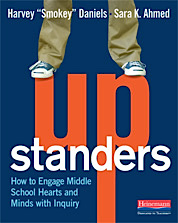Use Inquiry to Engage Hearts and Minds
Upstanders: How to Engage Middle School Hearts and Minds with Inquiry
By Harvey “Smokey” Daniels and Sara K. Ahmed
(Heinemann, 2014 – Learn more)

Progressive, experienced educators will find inspiration in this practical guide which sums up everything research has taught us about what quality instruction looks like today.
Novice, progressive educators will embrace the straight forward approach the authors use to outline engaging lessons that can be implemented immediately within the classroom. The only sort of educator I foresee having issues with the inquiry process detailed within these pages is the sort of educator who probably wouldn’t pick up this book to begin with — a “fossilized” teacher who is afraid to take risks.

Nonetheless, they are very knowledgeable, giving credit to other well-known educators from whom they have borrowed and adapted/incorporated innovative strategies. Overall, the book provides an excellent model for what strong educators do, which is acquire best practices from research, professional workshops and fellow teachers and blend them into one seamless approach to deliver a transformative curriculum.
Usability
I found that this book immediately lent itself to various areas of my work. So much so that I decided to share relevant parts of the book with my colleagues as I was reading. The brevity and friendly format assured them that it was a manageable read.
Chapter Three, “The Toolbox,” was extremely helpful for new teachers entering the profession and for my colleagues of different content areas. In initiating our new Response to Intervention (RTI) program, many of my fellow teachers had questions as to what constituted a “Read Aloud” versus a “Shared Reading.” Simple terms that can become mere jargon if not clearly defined were broken down by the authors. These commonly used ELA strategies were particularly helpful to other content area teachers who are now being expected to expand their literacy instruction.
Our school is also in the process of implementing a TED Conference Week this year where students will be developing their own short term curriculum based on their own interests and research, then delivering a TED talk to culminate the week. Much to my surprise, the chapter on “Open Inquiries” outlined the entire process that my team and I were getting ready to plan! The step by step guide not only answered all of our burning “what-if” questions, but it provided a great professional literature resource that we could share with our administration to justify this week-long, whole school project.
Various other activities are outlined in detail throughout the book and are easily transferable to any content area. They are well worth a read, and after having tried out a few myself in my own classroom, I can affirm that they are engaging and rigorous too.
The Heart of the Book
The biggest takeaway of Upstanders is the culture the book helps the reader establish within their own classroom. The authors spend a great deal of time highlighting the complexity of a teacher’s role – not just to teach the Common Core Standards, but to cultivate compassionate, socially responsible citizens for the future of our society. So if I have given you an impression that this book is simply a practical guide to strategies that one can apply to their classroom, it is, but it is also so much more than that.
It unlocks a path to develop the most difficult skill for young middle schoolers to achieve: to learn to be truly empathic. Part service learning, part inquiry, this approach teaches students to navigate an increasingly complex and hostile world, especially during the tumultuous middle school years.
The Upstanders approach aims to disarm bullies, to teach students to embrace cultural diversity, and to help students feel connected to others both locally and globally. It reinstates the values that our educational system has seemingly lost along the way.
As a teacher reading this book, I couldn’t help but eagerly flip each page, knowing that whatever information lay ahead was not only practical and applicable to what I do in my classroom each day, but would reassure me that what I value as an educator is still very relevant and that there are like-minded educators out there who also recognize the importance of teaching strong character traits, not merely content.
Mackenzie Grate has been a Title One middle school ELA teacher in New York City for the past 8 years. She has a BA in English Education and an MS in TESOL from New York University. She is currently earning her MA in Educational Leadership from The College of Saint Rose. Her hope is to one day open a school with her colleagues based on a collaborative teacher leadership model. Follow her on Twitter @ThisTeacherSays or read her musings about all things educational on her blog at MackenzieGrate.com. She goes by “Mack.”


































